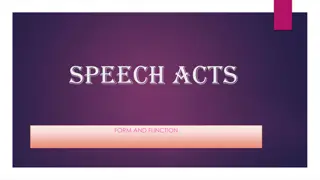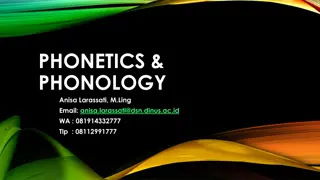Understanding Applied Linguistics: Definitions, Rationale, and Purpose
Delve into the realm of applied linguistics through a comprehensive outline featuring historical perspectives, defining moments, and the overarching purpose of this field. Explore how applied linguistics tackles language-related social issues and addresses challenges in education and communication.
Download Presentation

Please find below an Image/Link to download the presentation.
The content on the website is provided AS IS for your information and personal use only. It may not be sold, licensed, or shared on other websites without obtaining consent from the author. Download presentation by click this link. If you encounter any issues during the download, it is possible that the publisher has removed the file from their server.
E N D
Presentation Transcript
Outline Structure rationale Chapter 1 History and definitions Opening Quotation. It illustrates the text but doesn t necessarily provides relevant information for the outline. In Anna Karenina and Onegin not a single problem is solved but they satisfy you completely just because all the problems are correctly presented. (Anton Chekov, letter to Alexei Suvorin, 27 October 1888, in L. Hellman (ed.), Selected Letters of Anton Chekiv, 1955, translated by S. Lederer.)
Outline Structure rationale 1 - AVOIDING DEFINING Contextualization through a life experience. Again, no relevant information for the outline at this moment. In St Paul s Cathedral in London there is no monument to its architect, Sir Christopher Wren. Instead, an inscription in the cathedral reads: Si monumentum requires, circumspice. (If you seek a monument, gaze around.) The inscription is attributed to Wren s son. Whoever the author, its message is clear: the cathedral is itself a monument to its great creator. Christopher Wren needs nothing more than his own work to memorialise his achievement.
Outline Structure a sample One definition of applied linguistics is of this kind. It takes what we shall call the function view of applied linguistics. According to this view, applied linguistics must be defined through demonstration, that is by giving examples of its work. One reason for this is that providing a definition of applied linguistics is difficult. Its purpose, the amelioration of language problems (see Chapter 6) is not disputed. What is at issue is what sort of applied linguistics content leads to the skills and knowledge that will provide that amelioration. Even medicine, so obvious in its target, the amelioration of health problems , is hard put to make clear its theoretical position and to establish agreement on what the right content of medical education is that helps to provide a coherent framework for medicine and is not just opportunist visitations from different disciplines, anatomy biochemistry, psychology and so on. Possible definition of Applied Linguistics. Purposes for Applied Linguistics.
Outline Structure rationale Like medicine there is little disagreement about the purpose of applied linguistics, which is to solve or at least ameliorate social problems involving language. The problems applied linguistics concerns itself with are likely to be: How can we teach languages better? How can we diagnose speech pathologies better? How can we improve the training of translators and interpreters? How can we write a valid language examination? How can we evaluate a school bilingual programme? How can we determine the literacy levels of a whole population? How can we helpfully discuss the language of a text? What advice can we offer the Ministry of Education on a proposal to introduce a new medium of instruction? How can we compare the acquisition of a European and an Asian language? What advice should we give a defence lawyer on the authenticity of a police transcript of an interview with a suspect? Purpose of Applied Linguistics All those questions will be simplified to general terms.
Outline Structure rationale These problems of applied linguistics are not normally about more general social issues, such as unemployment, except very marginally. However what has come to be called critical applied linguistics does make that link. It takes up the kinds of applied linguistics problems we have listed and then places them within a broader political framework. I refer to critical applied linguistics in Chapter 2 and return to it more fully in Chapter 7. To be brought up in another section.
Outline Structure rationale So far I have used the term applied linguistics as if it were one word. But it is of course two words, like applied science, applied mathematics. The Shorter Oxford English Dictionary defines applied as: put to practical use; practical as opposed to abstract or theoretical . That seems straightforward enough. Let me turn to the second word, linguistics . Definition of applied
Outline Structure a sample Chapter 1 History and definitions 1 - AVOIDING DEFINING 1.1 Possible Definitions of A. Linguistics 1.1.1 Defined through a functional view. 1.1.1.1 understood by experience, work 1.1.2 The term applied meaning something practical. 1.2 Possible Purposes of A. Linguistics 1.2.1 to help solve problems in diverse social areas which involve language
Outline Structure tips Why should we write Outlines? To have fast access to texts in a logical, simple and clear way. To be able to still understand the text after some time without needing to read it all over again To be used as a study technique, To retain the text s information in the memory How should we organize an Outline? In a clear way, even though is not linear (sentence by sentence, paragraph format) Branching (allows the relation of ideas) Subordination one idea completes the other Coordination the ideas are of the same level
Outline- skills needed Conciseness Paraphrasing If you ever quote, insert page number
Format 1- Heading 1.1 Full reference of the piece in ABNT format 2- Text using key words, short sentences and branching 1-.... 1.1.... 1.1.1 1.1.1.1 2-....
Format Do not leave out information from the text UNLESS - It is not relevant to understand the text (see first slide) - It is repetitive. You have outlined that already























